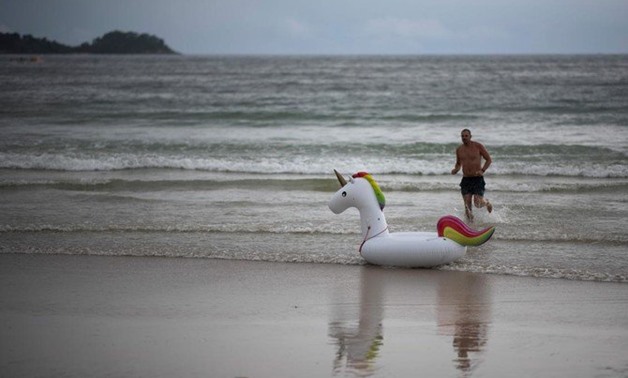
A tourist runs after his lose unicorn-floaty at the Patong Beach in Phuket on October 12, 2018. (AFP)
MANILA: The Philippines’ most famous resort island Boracay re-opens Friday after a six-month clean-up intended to fix the damage done by unrestrained mass tourism.
Here are some other global hotspots that authorities have moved to protect:
Officials on the holiday island, Indonesia’s top tourist destination, declared a “garbage emergency” last year after the palm-fringed Kuta beach was swallowed up by mountains of trash.
Indonesia, second only to China as the world’s biggest contributor to marine debris, deployed 700 cleaners and 35 trucks to remove roughly 100 tons of debris each day from Kuta and two other popular beaches to a nearby landfill.
Known for its 900-odd human figures standing up to 10 meters (32 feet) tall, the isolated Pacific island severely curtailed visitor numbers in August this year due to concerns over the remote Chilean territory’s environmental sustainability.
Tourist stays on the island, believed to have been settled by the Rapa Nui people around the 12th century, were cut to 30 days from 90, after the population — along with the crime rate — doubled in a few decades.
Those who wish to live on the island are now required to be a parent, partner or child of the Rapa Nui people.
Dubrovnik, which boasts an old walled city, saw cruise ship arrivals shoot through the roof after it was used as a backdrop in the smash television drama series “Game of Thrones,” causing congestion as tourists made a beeline for the shoot locales.
Mayor Mato Frankovic told AFP the authorities plan to cut cruise ship numbers coming into the Adriatic port, while deploying cameras to count the number of people entering the old town.
Venice authorities are trialling a system that forces visitors to make a reservation if they want to go to the popular Saint Mark’s Square during peak hours.
They are also fining tourists 500 euros ($585) for bathing or having picnics in the city’s famous canals.
In Florence, officials have resorted to hosing down public spots such as church steps where many visitors congregate to eat picnics. This aims to prevent people from sitting on the wet pavement.
Peruvian authorities increased surveillance at the 15th-century Incan citadel high in the Andes mountain range in 2014 as nude photos and streaking became increasingly common.
Tourists have since at least 2013 been posting their naked selfies on social media, which the government described as a “disrespectful act” aimed solely at getting attention.
The glittering Thai bay immortalized in the movie “The Beach” was closed indefinitely on October 1 to allow it to recover from the impact of mass tourism, after a four-month respite failed to ease beach erosion and pollution.
About 5,000 tourists had arrived by boat each day to the beach framed by limestone cliffs that was made famous by the 2000 film starring Leonardo DiCaprio.

Comments
Leave a Comment